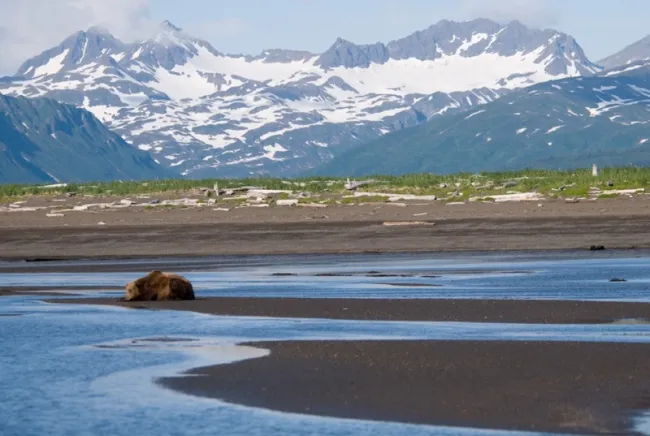
Katmai National Park and Preserve, located on the Alaska Peninsula, is renowned for its incredible wildlife, pristine wilderness, and volcanic landscape. Covering more than 4 million acres, this park is most famous for its bear-watching opportunities, particularly at Brooks Falls, where visitors can witness brown bears catching salmon. Katmai is also home to the Valley of Ten Thousand Smokes, a remnant of the largest volcanic eruption of the 20th century. Its remote location offers an unparalleled wilderness experience, far removed from the typical tourist destinations.
History of the Park
Katmai National Park was initially established as a national monument in 1918 to protect the area surrounding the Novarupta volcano, which erupted in 1912. The eruption created the Valley of Ten Thousand Smokes, a vast ash-filled valley that drew the attention of early explorers and scientists. Over the years, the monument was expanded, and in 1980, it was redesignated as a national park and preserve under the Alaska National Interest Lands Conservation Act. Today, Katmai is known not only for its volcanic history but also for its thriving wildlife populations, especially brown bears.
Main Features
- Brooks Falls: The most famous attraction in Katmai, where visitors can observe brown bears fishing for salmon. The falls are equipped with viewing platforms that provide a safe and optimal way to watch the bears.
- Valley of Ten Thousand Smokes: This area was created by the 1912 Novarupta eruption and is filled with ash flows and fumaroles. Guided tours are available for those interested in the volcanic history of the park.
- Wildlife Viewing: Katmai is a haven for wildlife enthusiasts, offering opportunities to see not only bears but also wolves, moose, and various bird species.
- Lakes and Rivers: The park is dotted with numerous lakes and rivers, including Naknek Lake, one of the largest in Alaska, and is a prime location for fishing and kayaking.
Types of Trails
Most of Katmai’s trails are undeveloped, offering a true wilderness experience. The park has a few established routes, including:
- Brooks Camp Area: There are several short trails around Brooks Camp, including the one leading to Brooks Falls and the Cultural Site Trail.
- Valley of Ten Thousand Smokes: This area offers both guided and self-guided trails, but the landscape is rugged and requires some hiking experience.
- Backcountry Routes: Experienced hikers can explore the vast backcountry of Katmai, though these routes are unmarked and demand proper preparation and navigation skills.
Crowd Expectations and Annual Visitors
Katmai is a remote park, receiving around 40,000 visitors annually. Most visitors come during the peak summer months of June through August to see the brown bears at Brooks Falls. Despite the growing popularity of bear viewing, the park’s size and remoteness mean it never feels overcrowded.
Accessibility for Seniors
Katmai’s remote location presents challenges for accessibility. Brooks Camp, the most visited area of the park, is accessible by plane or boat, and there are a few easy trails suitable for seniors, including the paths to the bear viewing platforms. However, much of the park remains rugged and difficult to navigate.
Accessibility for Wheelchairs
Brooks Camp offers limited accessibility for visitors in wheelchairs. The bear viewing platforms have ramps, but the trails are not fully accessible, and the overall rugged terrain of the park can be challenging. Visitors requiring mobility assistance should contact the park ahead of time to plan their visit.
Park Amenities
Katmai National Park has basic amenities, particularly in the Brooks Camp area:
- Visitor Center: Located at Brooks Camp, offering information, exhibits, and ranger-led programs.
- Restrooms: Available at Brooks Camp.
- Food Services: Limited food services are available at Brooks Camp, but visitors are encouraged to bring their own supplies.
- Gift Shop: A small gift shop is located at Brooks Camp, offering souvenirs and some basic supplies.
Camping Facilities
- Brooks Camp Campground: The only developed campground in the park, located near Brooks Falls. It has 60 sites available on a first-come, first-served basis, and reservations are recommended during peak season.
- Backcountry Camping: Permitted throughout the park, but it is essential to practice bear safety and Leave No Trace principles.
Access to Lodging
Lodging options are limited in Katmai due to its remote location. The primary accommodations are at Brooks Lodge, located near Brooks Camp. The lodge provides cabins and meals, but reservations need to be made well in advance, as space is limited. Other options include guided tours that may offer accommodations as part of the package.
Pet-Friendliness
Katmai National Park is not very pet-friendly due to the abundance of wildlife, particularly bears. Pets are allowed in the park, but they must be kept on a leash and are not permitted on trails, in the backcountry, or at bear-viewing areas. Bringing a pet to Katmai is generally not recommended.
Best Months to Visit
The best time to visit Katmai is during the summer months, from June to September. This is when the weather is most favorable, and the brown bears are actively fishing at Brooks Falls. July is the peak bear-viewing season, but visitors in September can also enjoy fewer crowds and vibrant fall colors.
Conclusion
Katmai National Park offers a unique and remote wilderness experience, with its world-famous bear viewing and striking volcanic landscapes. While accessibility can be challenging, particularly for those with mobility concerns, the park provides unforgettable opportunities for those who venture into its rugged beauty. Whether you’re interested in wildlife, geology, or simply seeking solitude in one of the most pristine corners of Alaska, Katmai has something to offer. Plan your visit well in advance, respect the wildlife, and immerse yourself in the natural wonders of this extraordinary park.



